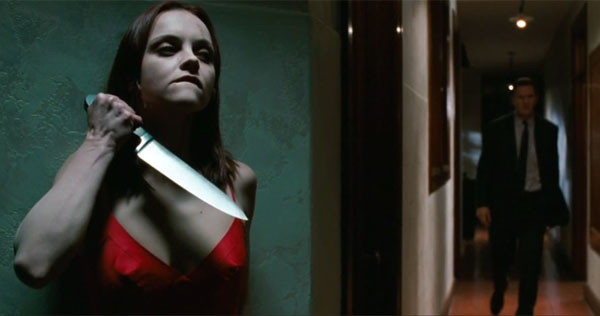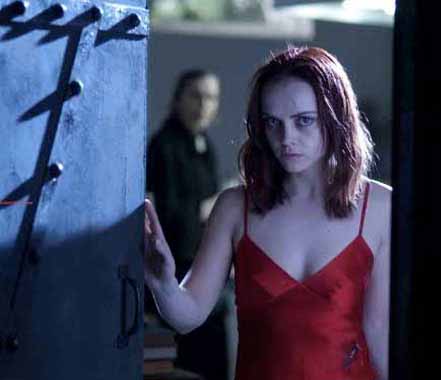
The recently released AFTER.LIFE is intended as a thought-provoking horror film, but the only lasting thought it provoked in me is the question: Why is Christina Ricci not a horror star? She is easily the best thing about the film; although playing what turns out to be essentially the victim role, she surpasses the chill-factor of her supposedly creepy co-stars (at least, their roles are meant to be creepy), projecting not only a melancholy gloom but also an eerie allure perfectly suited to the genre – one that goes beyond the surface and registers at some deeper, authentic level. She is obviously beautiful, but more than that, she is beautiful in the femme fatale sense that author James M. Cain meant when he had a character Serenade state that “true beauty has terror in it.”
I am perfectly well aware that Christina Ricci might not want to be a horror star (few actors want to be trapped in a genre like a helpless victim sealed inside a castle dungeon), but if the coffin fits, why not try it out?

AFTER.LIFE suggests that the fit would be perfect. In it, Ricci plays a woman who wakes up on a mortician’s table, apparently dead and bound for the afterlife but not quite ready to relinquish her mortal existence. The casting is perfect: Ricci’s dark-eyed countenance is at once attractive and disquieting, suggesting a morbid undercurrent beneath the character’s surface; she is every sad-eyed dreamer’s fantasy of a mysteriously alluring Goth girl, but she pulls this off with affectation – it’s part of her nature, not a matter of adopting a sullen, artificial pose.
With this kind of screen persona, Ricci should be top-lining a string of horror films and/or Gothic-romances; she would certainly be a welcome addition to – and a big improvement upon – the current crop of “romantic” vampires polluting cinema screens. That she is not is a mystery to which I do not know the solution, although I suspect it is part of the genre’s evolution away from horror stars in favor of concepts, makeup, and special effects. There is really no modern equivalent of Boris Karloff, Bela Lugosi, Lon Chaney, Vincent Price, Peter Cushing, and Christopher Lee, so why should we expect a modern version of Barbara Steele?
I’ll tell you why: because we deserve something more than Jigsaw and torture porn and anonymous remakes of ’70s slasher movies and tired retreads of J-horror hits. When you have a wonderful resource, tap it to its fullest potential; don’t let it waste away.

Not that Ricci’s career is wasting away. I just wish the horror genre would make use of her more often – and treat her better when it does use her. She certainly got off to a great start with her darkly comic turn as the young Wednesday Addams in the two amusingly creepy ADDAMS FAMILY films. She held her own opposite seasoned performers like Raul Julia and Angelica Huston, creating a memorable portrait of a sinister but lovable “outsider” who is adored precisely because she does not fit the traditional mold of a cute and cuddly film kid. This truly was a character – and a performance – that any horror fan could love.
This should have launched her into a long and successful career in the genre. I had hoped to see her cast as Claudia, the child-vampire in INTERVIEW WITH THE VAMPIRE, but the role went to Kristen Dunst instead. Maybe this was some kind of turning point; although Ricci continues to work consistently,she is not always getting the roles she deserves, while Dunst is starring in big-budget genre blockbusters like SPIDER-MAN. (Typically, when the two actresses crossed paths in 1998’s SMALL SOLDIERS, Dunst had the female lead, while Ricci supplied only a voice for one of the talking toys.)
Having missed out on a serious horror film, Ricci next appeared in another creepy comedy, the rather juvenile CASPER (1995). As the young girl whose father moves her into a haunted house, she comes across a bit like a younger version of Winona Ryder in BEETLEJUICE, but the film is too family-friendly to indulge in the dark wit that made ADDAMS FAMILY so memorable.

Ricci eventually got her chance to appear in a well-received horror blockbuster: after playing the title role in LITTLE RED RIDING HOOD, a 1997 short subject adaptation of the Grimm fairy tale, Ricci was cast in SLEEPY HOLLOW (1999). With its old-fashioned Gothic atmospheric approach to horror, complete with period setting, the film was a perfect match for Ricci; unfortunately, her role as an innocent love interest (and just barely a red herring in the murder mystery) did not exploit her talents to their fullest, and director Tim Burton had her hair dyed blond, softened her into a rather conventional looking leading lady. Ricci is not bad, but her own particular, foreboding charm is little in evidence. Why use the actress if you’re not going to use her strengths that enhance the genre?

Next year Ricci was in BLESS THE CHILD, starring Kim Bassinger – a mess that probably all involved would like to forget; I certainly have forgotten it, and I wasn’t even in it. CURSED (2005) at least had the smarts to play with Ricci’s potentially lethal allure, but the potential inherent in the casting is wasted. Ricci certainly looks great as the young woman who senses that she has acquired a new predatory nature, but Kevin Williamson’s tongue-in-cheek werewolf script has the character come across like a watered-down, feminized version of Jack Nicholson in WOLF, and director Wes Craven has Ricci perform some silly actions (such as sniffing her way through an office building when she discovers her new-found ability to detect scents). Another opportunity lost.
Since then, Ricci’s cinefantastique films have trended toward fantasy. She played the title role in PENELOPE, a self-described “fairy tale” about a woman with the nose of a pig. And she was Trixie in the Wachowski Brothers’ bloated live-action rendition of SPEED RACER. Even if she is good in these films, they don’t do justice to what she truly could achieve if some Hollywood genius would finally craft a vehicle that played to her strengths.
Which is why (among other things, admittedly) AFTER.LIFE is such a disappointment. The film casts her in a starring role for which she is perfectly suited, and for about the first third it seems as if it will work, the camera’s gaze treating her with the reverence of a connoisseur appreciating an object d’art. Suspended between life and death, Ricci displays the unreal vampire-like beauty of a carefully carved statue, an effect amplified by the cool photography that paints her skin in alabaster hues (the better to contrast with the bright red satin slip that is her costume throughout most of the running time – when she is not fully unclothed, that is).

In effect, she is the living embodiment of the ineffable Romantic ideal, too perfect to exist in our crude mortal world, and hence doomed to death and whatever lies beyond. She could be Poe’s Lenore and Annabelle Lee, lost loves now abiding with the angels. At one point in the film, she “walks in beauty like the night,” as Byron wrote of the raven-tressed woman who combined “all the best of dark and light.” More darkly still, she could be Baudelaire’s TheVampyre, the evil seductress “seeking whom she may devour.”*
The thrill that AFTER.LIFE sustains but – unfortunately – never fulfills is that Ricci’s character will embrace this new nocturnal existence and emerge reborn into darkness as some variation on Théophile Gautier’s “La Morte Amoureuse.” That the film fails in this regard is only the latest example of the horror genre failing to crown this dark princess as its rightful queen.
FOOTNOTE:
- In one of AFTER.LIFE’s mildly amusing moments, Ricci’s character, a school teacher, issues an order to some misbehaving kids, who hesitate before obeying. As she stares at them, you half-expect her to say, “Do what I tell you, before I drink every drop of blood in your bodies and devour your souls.”
[serialposts]

